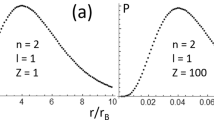Abstract
The new approach to calculation of transition form factors of hydrogen-like atoms is proposed. The explicit analytical expressions of transition form factors from arbitrary discrete states to continuum are obtained in terms of classical polynomials.
Similar content being viewed by others
References
B. Adeva et al., “Lifetime Measurement of π+π− Atoms to Test Low Energy QCD Predictions,” in Proposal to the SPSLC, CERN/SPSLC 95-1, SPSLC/P 284 (Geneva, 1995).
L. L. Nemenov, “Elementary Relativistic Atoms,” Yad. Fiz. 41, 98 (1985).
In Proc. of the Intern. Workshop on Hadronic Atoms “HadAtom99,” Bern, 1999, Eds. J. Gasser et al., BUTP-99/26, BUHE-99-08 (Bern, 1999); hep-ph/9911
L. D. Landau and E. M. Lifshits, Quantum Mechanics. Non-Relativist Theory (Nauka, Moscow, 1974) [in Russian].
K. Omidvar, “Bound-Bound Transitions in Hydrogenlike Atoms Induced by Fast Charged Particles,” Phys. Rev. 188, 14 (1969) and references therein.
A. O. Barut and R. Wilson, “Analytic Group-Theoretical Form Factors of Hydrogenlike Atoms for Discrete and Continuum Transitions,” Phys. Rev. A 40, 1340 (1989).
D. Trautmann, G. Baur, and F. Rosel, “Fast Evaluation of the Relativistic Ionization Form Factor: Momentum Space Representation,” J. Phys. B 16, 3005 (1983).
H. S. W. Massey and C. B. O. Mohr, “Collision of Slow Electrons with Atoms,” Proc. Soc. A (London) 140, 613 (1933).
I. S. Gradstein and I. M. Ryshik, Tables of Integrals, Sums, Series, and Products (Nauka, Moscow, 1971) [in Russian]; A.P. Prudnikov, Ya.A. Brychkov, and O.I.Marychev, Integrals and Series, Special Functions (Nauka, Moscow, 1983) [in Russian].
A. Nordsieck, “Reduction of an Integral in Theory of Bremsstrahlung,” Phys. Rev. 93, 785 (1954).
Reference Book of Special Functions Ed. by M. Abramovits and I. Stigan (Nauka, Moscow, 1979) [in Russian]; Y. L. Luke, Mathematical Functions and Their Approximation (New York, Academic, 1975).
O. Voskresenskaya, “Analytic Form Factors or Hydrogenlike for Discrete-Continuum Transitions. I. Transitions from n-States,” hep-ph/0111216.
B. Katkov and V. Strakhovenko, “Process of Electronic Recombination and Its Using at Electronic Cooling,” Zh. Eksp. Teor. Fiz. 75(10), 1269 (1978) [JETP 48, 639 (1978)].
Author information
Authors and Affiliations
Additional information
Original Russian Text © O.O. Voskresenskaya, S.M.-K. Bakmaev, 2006, published in Pis’ma v Zhurnal Fizika Elementarnykh Chastits i Atomnogo Yadra, 2006, No. 6 (135), pp. 33–37.
Rights and permissions
About this article
Cite this article
Voskresenskaya, O.O., Bakmaev, S.M.K. Analytical expression of transition form factors from discrete spectrum nS states to continuum states of hydrogen-like atoms. Phys. Part. Nuclei Lett. 3, 359–361 (2006). https://doi.org/10.1134/S1547477106060033
Received:
Issue Date:
DOI: https://doi.org/10.1134/S1547477106060033




